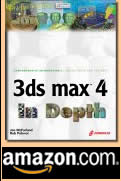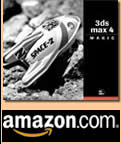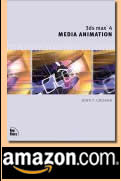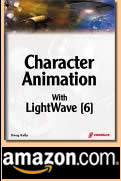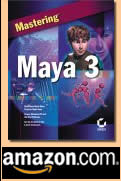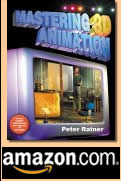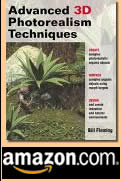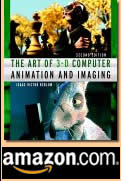|

Check out these awesome books for sale thru our affiliates! Read all about
it here, then click thru to make your purchase. Your click-thru-purchase
will give a percent of the sale to Mrs. Duck. You know you love to shop
online anyway-- so why not do it here where you are doing a good deed
at the same time? But you have to click-thru-purchase from here for it
to work!

 |
With release 4, max further establishes itself as today's dominant
modeling, animation, and rendering package. And with its fully revised
and updated coverage, Mastering 3ds max 4 further establishes itself
as the definitive max resource--just the book you need to master
all the techniques supported by this powerful product. Inside, you'll
learn all about sculpting and texturing your characters, setting
them in motion, lighting the scene, and producing the final animation--for
movies, games, television, and the Web. You also get in-depth instruction
in MAXScript, including detailed explanations of all that's new
to this release.
|
|
Paperback
- 848 pages Bk&Cd-Rom edition (July 2001)
Sybex; ISBN: 0782129382
|

|
3ds max™ 4 In Depth provides readers with a comprehensive reference
for creating effects for film, movies, and games. This book covers
the modeling and modification of structures from primitive objects,
plus other parametric design tools found in the program. 3ds max™
4 In Depth contains various projects to strengthen concepts learned
with a color studio to showcase the results. CD-ROM is included
with maps or clips needed for each exercise.
|
|
|
Paperback
- 768 pages Bk&Cd-Rom edition (June 8, 2001)
The Coriolis Group; ISBN: 1576108694 ; Dimensions (in inches): 1.61
x 9.18 x 7.39
|


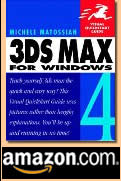 |
The popular Visual QuickStart Guide format offers clear, step-by-step
instructions, hundreds of screen shots, and easy-to-use visual tabs
for quick referencing. 3ds max 4: Visual QuickStart Guide leads
readers through the basics of MAX. Readers will start out by learning
max's interface, navigation and display tools, and will then move
on to modeling and transforming objects; surface mapping; rendering;
and creating full-fledged animations. This new edition offers all-new
coverage of Max's updated features, including its new interface
design, additional chapters, and a four-color signature showcasing
3ds max 4 creations.
|
|
Paperback
- 500 pages 1 edition (June 18, 2001)
Peachpit Press; ISBN: 020173429X ; Dimensions (in inches): 1.04
x 8.96 x 6.99
|

|
3ds max Magic will follow the same project-based pedagogy that has
made previous Magic titles a success. The primary goals are to present
changes in functionality, best practices, and inspirational effects.
Each project will be 10-15 pages in length and provide instruction
as well as suggestions for enhancing or modifying the project/effect.
Each page will be designed in a 3-column format with step-by-step
instructions on the left and corresponding graphics (or code) in
the middle. The third column will be used to provide additional
tips and tricks. Any effect, technique, or tip can easily be customized
to fit the readers' own design needs.
|
|
|
Paperback
- 320 pages 1 edition (May 15, 2001)
New Riders Publishing; ISBN: 0735710937 ; Dimensions (in inches):
0.61 x 8.05 x 10.06
|


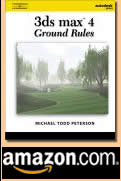 |
The first in our new Ground Rules series, this book paves the way
to mastery of 3ds max Release 4 basics - that is, the "ground
rules" - by inviting readers to work through thoughtfully crafted
examples, exercises, and tutorials for this powerful design and
animation tool. A refreshing alternative to command-driven books,
3ds max 4 Ground Rules puts novices on the fast-track to new skills
as it guides them to an understanding of the fundamental principles
underlying 3ds max Release 4 use. Fast-paced coverage spans the
entire spectrum, from exploration of the user interface through
Character Animation and Special FX. In addition, unique features,
such as AVI files and full-color inserts, result in an extraordinarily
interactive experience that goes beyond that offered by other introductory
books.
|
|
Paperback
- 672 pages Bk&Cd-Rom edition (May 16, 2001)
Delmar Publishers; ISBN: 0766837831 ; Dimensions (in inches): 1.01
x 9.13 x 7.56
|

|
In 3ds max 4 Media Animation, John Chismar has done it again –
only better! Following the lead of his highly acclaimed book 3D
Studio Max 3 Media Animation, John uses three professionally designed
projects to show readers the ins and outs of animation media for
broadcast. The clarity of John's instructions, the efficiency of
his processes, and the quality of his projects are sure to make
this book a success with animators and educators alike. The book
concludes with the deconstruction of three projects John created
this year as the Senior 3D animator for MSNBC.
|
|
|
Paperback
- 592 pages Bk&Cd-Rom edition (June 12, 2001)
New Riders Publishing; ISBN: 0735710597 ; Dimensions (in inches):
1.31 x 9.08 x 7.36
|


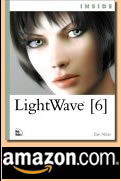 |
NewTek's LightWave has been a dominant player in the 3-D animation
tools genre since its origin on the Amiga platform, and the latest
version really shows its developers' commitment to keeping it at
the head of the pack. Inside LightWave 6 sheds light on the many
new features for the experienced LightWave user, and it's also a
solid learning tool for new users.
|
|
Paperback
- 896 pages Bk&Cd-Rom edition (July 24, 2000)
New Riders Publishing; ISBN: 073570919X ; Dimensions (in inches):
1.90 x 9.10 x 7.38
|

|
NewTek's sixth version of LightWave provides some powerful tools
for the animator who needs to create objects that walk and talk
and sing and dance--objects with character. Character Animation
with LightWave 6 showcases these new features, plus, for the new
user, the basics of character animation.
|
|
|
Paperback
- 816 pages Bk&Cd-Rom edition (November 20, 2000)
The Coriolis Group; ISBN: 1576103803
|


 |
LightWave is one of the leaders in the 3D graphics and design industry.
LightWave has set the standard in the industry with its modeling
interface and capabilities, and is considered a must-have tool by
the major movie and effect houses in the industry. In LightWave
6 Effects Magic, the contributors present two dozen effects (minimum)
created with New Tek's LightWave 6, all designed to show off the
considerable power and flexibility of the program. Effects are categorized
logically and cross-referenced to make finding particular components
of any effect easy to access later ("where did I see how to
do X?"). Each effect will be from 5 to 12 pages in length,
and consists of a 2-column layout, with step-by-step instructions
to the left, and corresponding graphics (or coded) to the right.
Any effect, tip or technique in this book can be extrapolated and
customized to suit the your own project needs.
|
|
Paperback
- 304 pages Bk&Cd-Rom edition (December 2000)
New Riders Publishing; ISBN: 0735709963 ; Dimensions (in inches):
0.66 x 10.25 x 7.96
|

|
Few computer animation systems are as comprehensive as Alias|Wavefront's
Maya. Version 3 is a massive package, and it takes Mastering Maya
3 almost all of its 1,000 pages to cover the program in depth. While
this is not a book for Maya beginners, it is certainly one that
every Maya user should eventually have. Six parts compose this massive
volume: "Fundamentals," "Modeling," "Animation,"
"MEL Scripting," "Rendering," and "Advanced
Effects." Liberally illustrated and annotated, each section
describes step-by-step techniques for learning to use or for understanding
each feature or topic. The writing in this book is matter of fact,
and each section gets down to business quickly in describing the
technique at hand. In light of this, imagine how much information
has been packed in 1,000 pages. The experienced Maya artist might
already know a lot of this information, but the easy stuff is discussed
and dismissed quickly, as if the book is anxious to dig deeper.
|
|
|
Paperback
- 800 pages Book & Cd edition (March 2001)
Sybex; ISBN: 0782128351 ; Dimensions (in inches): 1.99 x 8.99 x
7.51
|


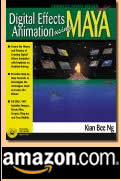 |
Digital Effects Animation Using Maya takes an interesting approach
to animation effects by categorizing them in terms of elements in
nature: fire, water, air, and earth. It also employs a fifth element,
dynamics, which governs the movement of the first four. Using these
elements as a paradigm, the book offers eight tutorials that demonstrate
ways of building scenes with fire, explosions, flowing water, splashing
water, terrain, and grass. The instructions in the tutorials are
all specific to Alias|Wavefront's Maya animation system, but many
of the principles discussed can be applied to other software packages.
|
|
Paperback
- 550 pages Bk&Cd Rom edition (September 1, 1999)
Charles River Media; ISBN: 1886801371 ; Dimensions (in inches):
1.30 x 9.25 x 7.47
|

|
For animators at all levels, provides readers with the essentials,
some presented in tutorial form, others in explanatory discussion.
Coverage includes NURBS and polygon modeling, deformation tools,
special effects, human features and figures, lighting and surfacing,
facial animation, and composition and cinematography. Ratner founded
and heads the Computer Animation Program at James Madison University.
The book is abundantly illustrated, and the included CD-ROM includes
useful models; it is compatible with high-end software such as LightWave,
Softimage, and Houdini, among others (mid-range packages will work
with some of the exercises).
|
|
|
Paperback
- 480 pages Bk&Cd-Rom edition (September 1, 2000)
Allworth Press; ISBN: 1581150687 ; Dimensions (in inches): 0.89
x 9.83 x 8.03
|


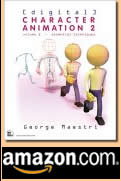 |
Grounded in the basics of traditional cell animation, Digital Character
Animation 2, Volume I: Essential Techniques provides the necessary
information to create convincing computer-generated characters in
3D. This step-by-step, full color guide applies conventional character
animation techniques such as walk cycles and lip sync to computer
animation, along with tips for giving your characters the illusion
of life. Volume I is the first of two volumes and is geared to more
entry level animators, teaching the basics. Volume II, soon to be
announced, will build on Volume I, covering more advanced concepts
and techniques. The cross-platform CD-ROM includes: multiple walk
cycles on various 3D programs; lip sync examples; texture maps;
and 3D models from REM Infografica.
|
|
Textbook
Binding
- 280 pages Bk&Cd Rom edition Vol 1 (July 1999)
New Riders Publishing; ISBN: 1562059300 ; Dimensions (in inches):
0.79 x 10.02 x 8.03
|

|
An indispensable guide from one of the world's leading authorities
on photorealistic The demand for 3D special effects in films, TV,
and commercial advertising is rapidly exploding. 3D graphic designers
are in high demand all over the world. Written by a widely respected
expert with a huge following among graphic artists, this guide explores
the most current advanced techniques for capturing realistic quality
in 3D images. It's the only book that covers advanced 3D photorealism
techniques for all programs and platforms. Packed with quality-enhancing,
time-saving techniques, this book shows artists how to create very
detailed models using Image Map modeling for adding depth along
with many other breath-taking effects. Graphic artists will find
proven techniques for creating organic surfaces (like trees) by
using Morph Targets, and find out how to design fantasy worlds in
natural environments.
|
|
|
Paperback
- 400 pages Bk&Cd Rom edition (June 14, 1999)
John Wiley & Sons; ISBN: 0471344036 ; Dimensions (in inches):
0.87 x 9.17 x 7.49
|


 |
New Riders' [digital] series is performing a tremendous service
to the computer animation and graphics community. The newest addition
to this family is [digital] Lighting & Rendering. Author Jeremy
Birn has long been regarded as a talented computer graphics artist
and generous writer, and he's been sharing his techniques and discoveries
for years. Using computer graphic and 3-D tools to create accurate
images is easy; using them to produce beautiful, inviting, memorable
images requires more than technical skill. [digital] Lighting &
Rendering introduces reasons and techniques for using light, shadow,
texture, and composition. The book is not software-specific, but
demonstrates techniques that are applicable to almost any 3-D graphics
application. It is assumed, however, that your 3-D software of choice
supports such basic rendering features as soft shadows, light maps,
colored gels, depth-of-field blur, motion blur, and so on.
|
|
Paperback
- 287 pages 1st edition (January 15, 2000)
New Riders Publishing; ISBN: 1562059548 ; Dimensions (in inches):
0.66 x 10.01 x 8.03
|

|
Many computer animation books focus on one specific program, and
if any historical information is referenced, it is merely to put
the program into perspective. While this approach is useful for
artists who need to learn more about an application, it creates
tunnel vision for anyone new to the field who is trying to get oriented.
The Art of 3-D Computer Animation and Imaging escapes this trap
by deftly illuminating the history of computer graphics and animation.
It brings the reader up to speed on current trends both in practice
and in research. Lavishly illustrated, this second edition includes
color images from such recent films as Blue Sky Studio's Oscar-winning
short, Bunny, and from Pixar's short, Geri's Game. The rendering
techniques used in Bunny and the animated cloth techniques used
in Geri's Game are discussed, as are topics like advanced modeling,
lighting, and shading and surface characteristics. Advanced animation
concepts such as motion dynamics, procedural animation, crowd animation,
and interactive animation are covered in chapter 12.
|
|
|
Paperback
- 448 pages 2 edition (May 11, 2000)
John Wiley & Sons; ISBN: 047136004X ; Dimensions (in inches):
0.79 x 9.10 x 7.52
|

|
|
Click through here to search for any title or item at Amazon.com.
When you click through and shop at Amazon from here, up to 5% of
your purchase will come back to support Mrs. Duck! You're going
to shop anyway. Why not have your dollars do good deeds by clicking
through from here to shop?!
|
|
![]()
![]()


![]()
![]()


![]()
![]()


![]()
![]()


![]()
![]()


![]()
![]()


![]()
![]()


![]()
![]()


![]()
![]()
